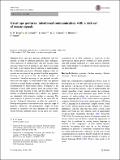Great ape gestures : intentional communication with a rich set of innate signals
Abstract
Great apes give gestures deliberately and voluntarily, in order to influence particular target audiences, whose direction of attention they take into account when choosing which type of gesture to use. These facts make the study of ape gesture directly relevant to understanding the evolutionary precursors of human language; here we present an assessment of ape gesture from that perspective, focusing on the work of the “St Andrews Group” of researchers. Intended meanings of ape gestures are relatively few and simple. As with human words, ape gestures often have several distinct meanings, which are effectively disambiguated by behavioural context. Compared to the signalling of most other animals, great ape gestural repertoires are large. Because of this, and the relatively small number of intended meanings they achieve, ape gestures are redundant, with extensive overlaps in meaning. The great majority of gestures are innate, in the sense that the species’ biological inheritance includes the potential to develop each gestural form and use it for a specific range of purposes. Moreover, the phylogenetic origin of many gestures is relatively old, since gestures are extensively shared between different genera in the great ape family. Acquisition of an adult repertoire is a process of first exploring the innate species potential for many gestures and then gradual restriction to a final (active) repertoire that is much smaller. No evidence of syntactic structure has yet been detected.
Citation
Byrne , R W , Cartmill , E , Genty , E , Graham , K E , Hobaiter , C & Tanner , J 2017 , ' Great ape gestures : intentional communication with a rich set of innate signals ' , Animal Cognition , vol. 20 , no. 4 , pp. 755-769 . https://doi.org/10.1007/s10071-017-1096-4
Publication
Animal Cognition
Status
Peer reviewed
ISSN
1435-9448Type
Journal item
Collections
Items in the St Andrews Research Repository are protected by copyright, with all rights reserved, unless otherwise indicated.
Related items
Showing items related by title, author, creator and subject.
-
A gestural repertoire of 1-to 2-year-old human children : in search of the ape gestures
Kersken, Verena; Gomez, Juan-Carlos; Liszkowski, Ulf; Soldati, Adrian; Hobaiter, Catherine (2019-07) - Journal articleWhen we compare human gestures to those of other apes, it looks at first like there is nothing much to compare at all. In adult humans, gestures are thought to be a window into the thought processes accompanying language, ... -
GesturalOrigins : a bottom-up framework for establishing systematic gesture data across ape species
Grund, Charlotte Vicki Christina; Badihi, Gal; Graham, Kirsty Emma; Safryghin, Alexandra; Hobaiter, Cat (2023-03-15) - Journal articleCurrent methodologies present significant hurdles to understanding patterns in the gestural communication of individuals, populations, and species. To address this issue, we present a bottom-up data collection framework ... -
Referential gestures are not ubiquitous in wild chimpanzees : alternative functions for exaggerated loud scratch gestures
Wilke, C.; Lahiff, N.J.; Badihi, G.; Donnellan, E.; Hobaiter, C.; Machanda, Z.P.; Mundry, R.; Pika, S.; Soldati, A.; Wrangham, R.W.; Zuberbűhler, K.; Slocombe, K.E. (2022-07) - Journal articleA fundamental aspect of human communication is our ability to refer to external objects and events through both words and gestures (such as pointing), yet the evolutionary origins of such signals remain obscure. Apes, ...

